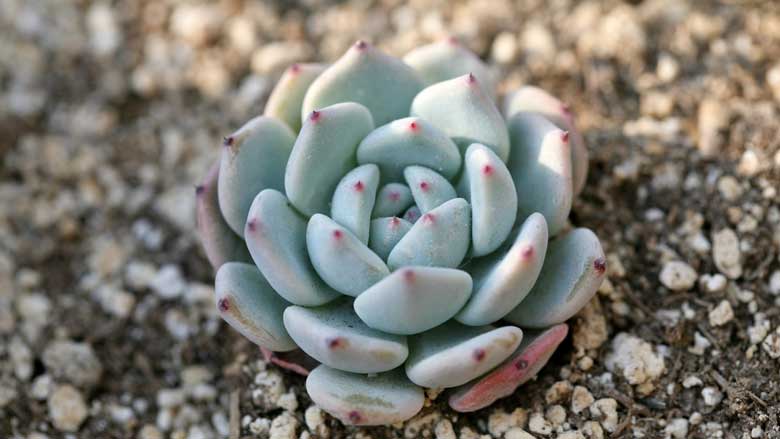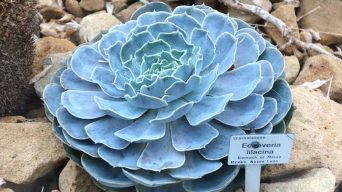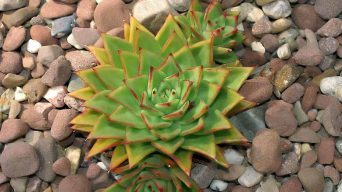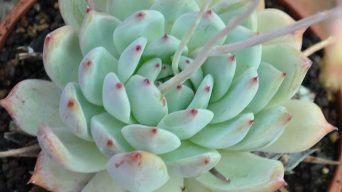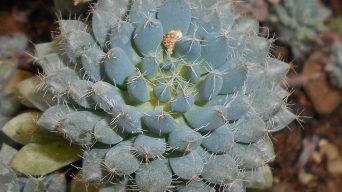Growing succulents can be fascinating and exciting.
However, succulents can also be challenging to care for if you don’t know what you are doing. Succulent propagation is no exception.
Echeveria minima is a beautiful plant that you can use to start your own Echeveria collection easily.
This small plant is very low maintenance and can be cultivated in both indoor and outdoor spaces.
This article will teach you everything you need to know about taking care of and growing Echeveria minima, including how to propagate your own succulent plants.
Overview
Echeveria minima, a flowering plant from the Crassulaceae family native to Mexico, is often known as the miniature echeveria.
Echeveria minima is a tiny succulent with blue-green rosettes measuring up to 1.6 inches (4 cm) in diameter. The leaves are packed so tightly that only the upper portions are visible.
The leaves are glaucous green with well-defined edges and a reddish tint to the margins.
In late spring, racemes of tiny bell-shaped flowers appear. The flowers are a bright yellow, with a pink or reddish lower section.
How To Care for Echeveria Minima
Echeveria minima care is a very easy process, making it the perfect houseplant to keep for beginners.
Below you’ll find the essential information you need to know about caring for your Echeveria minima succulent plant.
Sun Exposure & Light Requirements
Echeveria minima plants need full sun to partial shade to grow properly.
When direct sunlight is too strong for a succulent, it will display symptoms like brown spots on the leaves. In this case, move it to a shadier area.
Also, if the succulent isn’t getting enough sunlight, its leaves will stretch out, looking for light. Don’t worry, though; this is normal!
For optimal growth, place your Echeveria minima in an area with six hours of bright sunlight daily. Make sure to rotate it every day so that all sides are exposed equally.
Watering Requirements
Echeveria minima succulent plant needs to be watered every one to two weeks. The soil should always be completely dry before the next watering.
Watering frequency may vary from one climate to another.
In hot and dry regions, it is essential to be careful with the water intake since Echeveria minima succulent can get badly damaged by over-watering.
On the contrary, the Echeveria minima succulent in humid climates does not need to be watered so often.
Remembering that this plant should always have a dry period before watering again is important.
Watering your Echeveria minima succulent when the soil is too wet could get rot and die.
Soil Requirements
Echeveria minima succulent plant prefers to be planted in fast-draining soil.
The soil should be rocky and porous to ensure that there is enough drainage for the excess water.
An example of a fast-draining soil would be a cactus mix.
If you use a regular potting mix, you should add coarse sand or gravel and perlite to the soil to encourage more drainage.
Temperature and Humidity
Echeveria minima succulents are native to Mexico and thrive in tropical and subtropical climates.
It typically resides in shaded places such as rock crevices and lower valleys, where the temperatures range from 68° to 80° Fahrenheit (20 to 27°C) during the day and 55° to 68°F (13 to 20°C) at night.
Though the temperature range is broad, these plants do not like extreme heat or cold. They prefer an average room temperature that hovers around 70°F (21°C), and they can die if kept too warm.
The humidity also varies by location and time of year, but the relative humidity should be maintained at around 40% for optimal growth.
Fertilizing
Echeveria minima, like most succulents, require very little fertilizing.
If you decide to fertilize your plant, be sure it is only once or twice a year during the growing season, from early spring to summer.
Use a balanced fertilizer diluted to half-strength with water or until the water is cloudy, and apply it to the soil at the base of your minima.
The Miniature Echeveria is sensitive to over-fertilizing, so be careful when fertilizing your plant.
Potting and Repotting
Echeveria minima is a slow-growing succulent plant that prefers to be slightly pot-bound.
This means you should only repot your succulent plant when it becomes root-bound, or the roots are showing out of the drainage holes at the bottom of your pot.
Root-bound plants often have a thickened, wrinkled stem and may make little offsets around the mother plant’s base.
When repotting your succulent plant, it is essential to use a pot with drainage holes at the bottom of its base.
Although succulents prefer slightly dry soil, they cannot handle overly wet soil very well. They will likely suffer root rot if kept in continuously damp conditions for an extended time.
If your Echeveria minima’s roots are already sticking out of the drainage holes in its pot, use a pair of pruning shears to snip them off cleanly.
This process reduces water loss through transpiration by allowing excess water to drain freely from the soil.
You should also trim off dead or damaged roots and thickened, older ones that no longer grow actively.
Pruning
Echeveria minima is a slow-growing succulent plant, and, as a result, you will rarely have to prune it.
However, removing dead leaves, flowers, and branches can help improve the health and appearance of your Echeveria minima.
If you choose to prune your succulents, sterilize your tools after cutting off any dead or dying parts to avoid spreading any diseases.
Pests and Diseases
Although Echeveria minima succulents are relatively easy to care for, it is important to be familiar with the main pests and diseases that come with them.
This will allow you to easily diagnose any problems or concerns you have so that they can be addressed quickly.
Pests
The most common type of pest found in Echeveria minima succulents is mealybugs.
These tiny insects are white and can be found around the crown of the plant.
They feed on plant sap by inserting their mouthpart, called a stylet, into the tissue of young leaves or stems.
As they feed, these insects secrete honeydew, which is sticky on the leaves.
Mealybugs also produce a fine white, powdery wax covering their bodies and protecting them from natural predators like ladybeetles.
This insect can cause severe damage to the succulent by removing sap, inhibiting growth, and leaving behind an unpleasant residue around the base of the plant.
Some less common pests include aphids, winged insects covered with a white waxy substance.
These insects feed on the succulent by sucking out plant juices and secreting honeydew.
Scale is the final type of pest that may inhabit Echeveria minima mist plants.
These tiny organisms attach themselves to stems or leaves and suck out plant juices.
They are oval-shaped and can be of various colors but typically appear as light brown or grey.
These insects all have similar symptoms: discoloration and spotting of leaves, yellowing and wilting of stems and tips, curling or distortion of leaves, and stunted growth.
Diseases
Although Echeveria minima succulents are hardy and generally disease-resistant, they may develop rot or mildew if exposed to too much moisture for an extended period.
The best way to avoid this is to ensure proper drainage in the potting soil and avoid overwatering.
Another common disease of Echeveria minima succulents is leaf spots.
These are very common in climates that have hot, wet summers or cold winters.
The lesions on the leaves may be brown, black, or dark grey and typically develop around the leaf margins.
Again, minimizing water exposure is helpful to avoid these diseases while also ensuring proper drainage occurs in the soil.
The last type of disease that could affect Echeveria minima succulents is rust.
This fungus can affect many plants and is typically more common during hot, humid summer weather.
The symptoms include small yellow or orange spots on the leaves’ lower surfaces, which increase in size over time.
In terms of preventing these diseases from occurring in your Echeveria minima succulent, be sure to water correctly and avoid excess moisture near the plant.
Also, make sure to remove any infected leaves as soon as you spot them to prevent the spread of disease throughout your succulent’s foliage.
How to Care for Echeveria Minima in Winter
Echeveria minima are not cold-hardy and should not be exposed to frost or cold temperatures.
In winter, this plant requires special care to ensure its survival.
Light
As such, Echeveria minima is a sun-worshipper and should be planted in full sun.
A location that faces east or west is considered ideal for this plant.
Watering
Echeveria minima succulents are very drought tolerant and should be watered sparingly.
Reduce watering even further during the winter months to only occasional watering; otherwise, the roots might rot.
Air Circulation
Ensure that there is enough air circulation around Echeveria minima to prevent the formation of fungal diseases. Keep the succulent in a well-ventilated area and away from stagnant air.
Fertilization
During winter, Echeveria minima should not be fertilized.
Winter Temperature
During winter, the nighttime temperature should not drop below 5°C (40°F). Temperatures above 25 °C (75 °F) are preferable.
When temperatures drop below 5 °C (40 °F), you should bring the succulents indoors and keep them in an unheated room.
How To Propagate Echeveria Minima
Echeveria minima can be propagated from leaves and offsets.
Propagating From Offsets
Offsets are baby plants growing from the base of a larger Echeveria.
To propagate offsets, you should carefully remove them from the mother plant and pot them in their own pot to grow into a full-fledged succulent plant.
To propagate from offsets, use your finger to gently rub off (or cut) the offset from the main plant.
Most offsets will have a visible white root protruding from the end you cut off, showing that it is ready to be rooted in its own pot.
To start, fill a small pot with succulent or cacti potting mix and set it aside.
Next, carefully remove the offset from the mother plant, making sure to get as much of its roots as possible.
Then use a chopstick or skewer to gently poke holes in your container that you prepared previously, about one inch deep and staggered so that each hole is only partially covered by soil.
Next, place the offset into a hole and cover it with soil. Pat the soil down gently to make sure that the offset is secure. Repeat this process until all of your offsets are potted.
Finally, place your newly propagated Echeveria Minima in a sunny location so they can establish their new roots. Water them just enough to keep the soil moist until new growth appears.
After new growth has appeared, water your offsets only when the top of the soil feels dry.
Propagating From Leaves
Echeveria Minima can be propagated from leaves.
To propagate from leaves, start by picking a leaf with an intact base that is big enough to not fall over in your pot.
Carefully cut off the leaf base with a sharp pair of clean scissors or garden shears (be careful not to damage your plant in the process).
Allow the leaf to callous over (dry out) for about 2 to 3 days. This will ensure that your leaf does not rot while it is waiting to be planted.
Next, fill a pot with succulent or cacti potting mix and place the leaf on top of the soil.
At this point, you should have a leaf laying flat on top of the soil, with its base slightly covered by soil.
Pat down the soil around it to secure the leaf, and will not fall out or blow away. Next, water enough to moisten all of the soil but not flood it.
Finally, place your newly propagated Echeveria Minima in a sunny location so they can establish their new roots.
Water them just enough to keep the soil moist until new growth appears.
After new growth has appeared, plant your Echeveria Minima in a permanent location and treat it as you would other Echeveria.
Final Thoughts
Echeveria minima care and propagation are very basic and straightforward.
This plant is perfect for those who wish to have an extensive succulent collection but lack the time and experience to care for more delicate succulents.
The steps that need to be taken in order to take care of this type of succulent are all very straightforward and easy to follow.
If any problems do arise, one should not fear trying to rectify them, as any amateur can easily handle Echeveria minima care and propagation.

